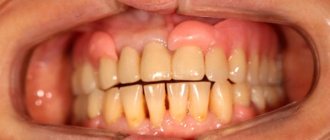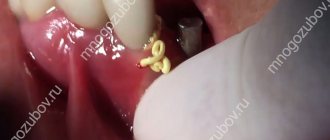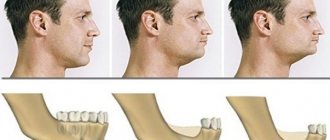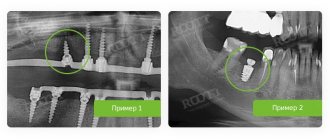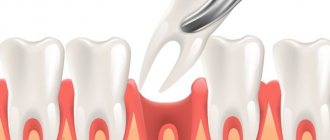Dental crowns are a popular and minimally invasive way to restore natural teeth. They are used when, for example, the crown of a living tooth is damaged by caries, mechanical trauma or previous root canal treatment. Thanks to prosthetic crowns, restored teeth look aesthetic, healthy and natural. When choosing a dental crown, patients at the Dental Brothers dental clinic often have questions about its strength, safety, and whether the crown can fall out.
Do you need a pin for a crown?
If the doctor insists on prosthetics, this already means that the tooth has undergone significant destruction. The crown helps restore the chewing function of the damaged unit and the aesthetics of the smile, this is especially true for the frontal region. Obviously, the prosthesis must have the necessary support. If there is a sufficient amount of natural tissue, the crown is placed directly on the tooth. In other cases, pins and stump inlays come to the rescue.
- Tooth decay of more than 30% is a good reason for installing a pin and crown.
- A chip of one of the walls of a tooth by 50% or more or a fracture at the root are indications for installing a core inlay and crown.
The technology also has limitations. A pin cannot be placed if there is untreated pulpitis, periodontitis and their complications (cyst, gumboil, etc.). Treatment will have to be abandoned if there are abnormalities in the structure of the tooth roots (too much curvature or thin walls). In some situations, the doctor is unable to unfill the canals after previous endodontic treatment, which also affects the possibility of installing a pin.
Why can an implant unscrew from the gum?
Unscrewing an implant from the gum is a rare occurrence, but such cases do occur. The loss of a titanium rod is not always the fault of the implantologist; sometimes the patient himself or the manufacturer is to blame. When unscrewing the implant, you need to pay attention to how long after implantation this happened. If the incident occurred in the first weeks, we can conclude that the implantologist is to blame.
Reasons may be:
- insufficient study of the patient's medical history;
- improper antiseptic treatment;
- poor quality tool;
- melting of the bone due to incorrectly calculated load and selection of an inappropriate dental system.
In all these cases, the patient may experience peri-implantitis, accompanied by tissue destruction and granulation. Treatment of the lesion in the oral cavity and treatment of the upper and lower parts of the structure are required. In advanced cases, the only way out is to remove the entire structure.
In case of early unscrewing of the implant, you need to send a complaint to the manufacturer. Possibly the reason was poor quality material.
The removal of the titanium root can also be caused by applying excessive force when unscrewing the plug or former. If the implant began to wobble and fell out much later (at least after 1-2 years), the patient himself is most likely to blame. The structure could have come loose due to non-compliance with hygiene rules or the dentist’s recommendations.
Inlay or pin: which is better?
The choice of support element depends on the specific clinical case. Both the pin and the core tab perform similar functions. However, each solution has its own advantages and disadvantages.
| Crowns on pins | Crowns on core inlays |
|
|
The stump tab is considered a more reliable option for chewing teeth and if it is necessary to install bridges. It is important to understand that this significantly increases the cost of treatment (the price per tab can reach up to 10,000 rubles). In addition, the manufacture of a stump insert requires an additional laboratory stage and appropriate manipulations.
Placing a crown on a pin can be recommended if the tooth does not have serious damage and there is no risk of pin breakage and root canal injury under the influence of chewing load. However, not all pins are suitable for the restoration of anterior teeth, especially if metal-free crowns are used. The crown and post on the front tooth should not contain metal if you want good aesthetics.
When installing a ceramic crown on a front tooth, the core inlay should also be made of ceramic.
Filling on a pin or crown: which is better?
This question interests many patients, and the answer is obvious. From the point of view of strength and reliability, the best option would be to install a pin and a crown. It is better to place a pin in a tooth under a crown in cases where the tooth is significantly damaged, especially when it comes to molars. A pin with a filling is installed for less significant damage and most often on the front teeth. This method also has its advantages. Firstly, this is a much cheaper technique. Secondly, all treatment takes place in one visit. The patient quickly returns to normal life and forgets about his problem. However, a filling with a pin gives a less reliable and predictable result.
What needs to be done to make the bridge last as long as possible
In order to extend the service life of the bridge, we must not forget that although it is an artificial structure, it should be treated like “natural” teeth. That is, do not load the bridges with excessively hard and stretchy food, regularly brush your teeth with a brush and toothpaste. Another important rule is that you need to visit an orthopedic dentist every 6 months. During a preventive examination, the doctor will examine the condition of the oral cavity and installed dentures, and will carry out professional removal of tartar and plaque.
1Yamamoto M. Basic technique for manufacturing metal-ceramic dentures, 1998.
Your questions and answers
QUESTION Hello, the bridge fell out of the teeth along with the pins. Can it be put back or not? And what is the best way to do this? Oksana
ANSWER Hello, Oksana. It's best not to try to glue the bridge in place yourself, because... This is fraught with complications, and consult an orthopedic dentist. Because there are many nuances due to which the old prosthesis can either be put back or not be used further (i.e., a new one can be made). But, given that your bridge fell out instead of the pins, most likely you won’t be able to put it back in place.
Author: Sambuev B. S. (Thank you for your help in writing the article and the information provided)
Stages of installing a crown on a pin
- Initial consultation, determination of indications and contraindications for treatment.
- Preparation of tooth tissues and depulpation of root canals.
- Installation of the pin.
- Taking impressions or 3D modeling. Sending the results to the laboratory to make a permanent crown. Immediately after the procedure, the patient is offered a temporary crown.
- Trying on the finished product and fixing the crown with a pin.
Service life and design reliability
The service life of a crown on a tooth on a pin is quite decent if the treatment was carried out efficiently, and the patient avoided injury and followed the doctor’s recommendations. Even a classic metal-ceramic crown with a simple anchor pin costs on average 7–8 years. A more expensive ceramic crown on a fiberglass post will last even longer.
If during use the crown begins to wobble, then this is a bad sign, regardless of whether it is with a pin or without a pin. In this case, you need to consult a doctor as soon as possible. If the crown and pin fall out completely, this may be due to improper treatment, pathological processes in the root canals, or a banal injury. Repeated treatment in most cases is no longer possible.
How to prevent the risk of tooth implant loss?
According to statistics, positive results from dental implantation are observed in 90-95% of cases. In order for the upcoming procedure for implanting a dental structure to be successful and not lead to complications, the patient needs to adhere to some recommendations.
Expert advice:
1. The most important thing at the stage of preparation for implantation is to choose a good dental clinic, where experienced implant dentists work, who have mostly positive reviews from patients.
2. Use high-quality implants from trusted global manufacturers for implantation.
3. Before the implantation procedure, it is necessary to conduct a full examination and sanitation of the oral cavity. Provide the doctor with all information about existing chronic diseases. An experienced dentist, having studied the patient’s complete medical history, will be able to foresee possible risks of complications and select the most suitable design for implantation, taking into account the characteristics of the patient’s body.
4. Do not refuse to install an implant from a trusted manufacturer if it is strongly recommended by the attending physician, even if the cost of the orthopedic structure exceeds the available budget. It’s better to pay more once, but solve the problem of missing teeth without adverse consequences.
5. Responsibly follow all doctor’s prescriptions and recommendations after installing an artificial tooth.
How much does it cost to put a crown on a post?
The price of the finished solution directly depends on the materials of the pin and crown. The cost of a regular anchor pin is 500 rubles, but for a fiberglass one you will have to pay more than 1000 rubles. But these figures pale in comparison with the range of prices for crowns. If ordinary metal-ceramics costs 6–8 thousand, then products made of ceramics and zirconium will cost three times more. All preparatory manipulations will need to be added to the final amount.
An E-Max ceramic crown on a fiberglass pin, together with all stages of treatment, can cost 30,000 rubles and even more if we are talking about a VIP-class clinic. You can also choose a budget option with a metal-ceramic crown and an anchor or titanium pin. This solution will cost from 12,000 rubles, but is not suitable in all cases.
Why does the gum former get twisted or fall out?
- Loose abutment of the former caused by excessively deep implantation of the titanium pin into the bone. Bone tissue grows on top of the implant, which prevents the former from being firmly attached.
- Incorrect choice of size or shape of the structure, poor-quality thread manufacturing.
- Poor adhesion of the rod to the bone due to the low density of the latter.
- Development of the inflammatory process.
The patient's action when the former is wobbly or twisted is to urgently contact the dental clinic to avoid worsening the situation.
The doctor will re-screw the former or install a new one. If the procedure is not carried out in time, the hole will become overgrown, which will require repeated cutting of the gums.
- Complete restoration of the dentition in just 4 days!
more detailsRoott Pterygoid Implants Sinus lift is no longer needed!
more details
Once and for life! Express implantation in 4 days with a permanent ReSmile prosthesis
more details
All-on-4, All-on-6, ReSmile, Zygomatic implantation We use all modern methods of dentition restoration
more details
Doctor's actions:
- If the implant was installed too deeply, excess bone tissue must be removed.
- If jaw bone density is low, calcium-containing medications are prescribed.
- If the cause is the development of inflammation, then removal of the artificial root and former will be required.
- The doctor can tighten the thread or replace the former.



